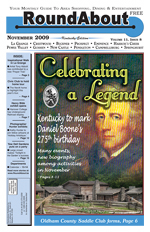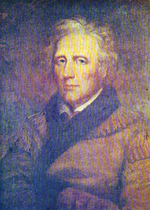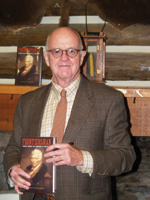



Celebrating a Legend
Kentucky
to mark
Daniel Boone’s 275th birthday
Many
events statewide, new book
by author Brown, among Boone
activities planned in November
By
Helen E. McKinney
Contributing Writer
 |
|
November
2009 |
(November 2009) – Even though he was born and
raised in New York City, Meredith Mason Brown has Kentucky blood running
through his veins. His ancestors knew and worked alongside Daniel Boone
on the Kentucky frontier, and it is this impetus that fueled him to
pen a new biography on Boone in time to celebrate Boone’s 275th
birthday.
“Boone was more complicated than you’d think of a woodsman,”
said Brown, 68. He has compiled hours of research into “Frontiersman
Daniel Boone and the Making of America.”
From the time he was old enough to remember, Brown recalls a rifle hanging
on the wall of his father’s study. This wasn’t just any rifle;
it had belonged to his ancestor, Col. John Floyd. Floyd had been acquainted
with Boone and is credited with helping Boone rescue his daughter, Jemima,
and the two Callaway girls from Indians in July 1776 outside of Fort
Boonesborough, near present-day Richmond, Ky. It is this personal connection
to Boone and the knowledge of his own ancestor’s role in history
that spurred him to put pen to paper and recount Boone’s life in
a new light.
In “Frontiersman,” Brown has tackled a topic that has been
written about countless times. Relying upon his own perspective and
background, Brown created a work that provides a fresh perspective on
Boone when there are only the same primary sources to draw from that
have been referred to by many other authors over the last two centuries.
|
Searching
for Boone (November 2009) – For as long as I can remember, my
paternal grandmother told me we were related to Squire Boone.
Well, that’s nice, but there are only 1,001 Squire Boones
out there living in the same time period as famed woodsman Daniel
Boone who were related to him. Which Squire Boone? • RoundAbout contributing writer Helen E. McKinney is a La Grange, Ky., native who resides in Shelby County. Email her at: hlnmck@aol.com. |
Men such as historical researchers Lyman Draper and John
Dabney Shane, who sought out oral histories of many early pioneers,
the Filson Historical Society in Louisville, and the Kentucky Historical
Society in Frankfort are major source holders for primary materials.
Any serious researcher will sift through voluminous records of musty
books and delicate original documents such as deeds, marriage licenses
and court order books to ascertain what history is really all about.
For individuals like Brown, it’s all about the person that Boone
really was. A glimpse of the true man can be found by digging deep and
piecing together what history has recorded of this sometimes larger-than-life
figure.
In addition to the already mentioned sources, Brown looked at many depositions
given by Boone involving land dispute suits. “You can almost hear
Boone talking in those depositions,” he said. “Boone played
an important role in western settlement.”
The Kentucky Historical Society houses the Martin F. Schmidt Library,
which contains a few original records in various collections that are
connected to Boone. These include land surveys in their online library
catalog and digital collections websites. The Kentucky Historical Society
also contains primary sources from some of Boone’s contemporaries,
and records pertaining to his relatives, including Squire Boone, said
Bill Morris, Library Technician.
“We have a few historical researchers who come here to do research
on Boone, but the majority of our Boone researchers are family history
and genealogy researchers who have either an established or suspected
link to the man,” said Morris. “The most unique type of resource
we hold here at the library are our surname files, which contain research
notes, family group sheets, obits and clippings, which researchers have
left with us.”
In honor of Boone and his accomplishments, the Kentucky Historical Society
plays host to an annual member gathering, which features scholarly speakers,
symposia and other special activities, said Russell Harris, Senior Associate
Editor of The Register. Known as “Boone Day,” it celebrates
the date, June 7, 1769, when Boone first viewed what is now known as
the Bluegrass Region of central Kentucky, after traversing the mountainous
terrain between the Cumberland Gap and the overlook at what came to
be known as Pilot Knob in present day Rockcastle County, Ky.
Both Morris and Harris agreed that “Although Boone is not the only
early explorer to have a lasting association with Kentucky, he holds
the most prominent place among his peers in terms of popular folklore
and culture, if not historical significance.”
At the time Boone lived, 1734-1820, there were many changes in America.
This is the overriding concept of Brown’s book. During his lifetime,
the United States was not officially the United States until 1776. Kentucky
was a territory of Virginia until becoming a state in 1792. A westward
drive of settlement (Kentucky being the west at the time), the killing
of precious game and the breaking of Indian power in the eastern United
States all took place during Boone’s lifestime. These were monumental
changes in a society that was still trying to define itself.
“His achievements made him news,” said Brown. “Boone
was always on the frontier,” whether it was in Kentucky, Missouri,
or wherever his sense of exploration took him.
It was his “tales that drew settlers to Kentucky.”
Bill Farmer, Fort Manager at Fort Boonesborough State Park, said, “The
more things change, and the farther away from our founding principles
we get, the more important it becomes to recognize the type of people
who helped make this country great. Boone played a very significant
role in several aspects of the exploration and settlement of this part
of the country, was part of the larger picture at a “national”
level, and was a man of good character.”
Part of his good character can be attributed to his Quaker upbringing.
“The Bible was one of his two favorite books, the other being Gulliver’s
Travels,” said Brown. He added that Boone was not an illiterate
woodsman. Boone was a compilation of many things: a hunter his entire
life, but also a surveyor, land investor, trader and tavern keeper.
|
See
What Boone Saw •
Cumberland Gap National Park: Daniel Boone blazed the Wilderness
Road through the Cumberland Gap in the Appalachian Mountains and
hunted this area extensively. Visitors can view some of the same
beautiful vistas, unique sandstone formations, impressive underground
caverns and diverse animal and plant life that Boone saw. Visit
www.nps.gov/cuga. |
Boone was able to adapt to his surroundings and use them
to his advantage. While growing up in Exeter, Pa., “Boone became
fond of life in the woods,” writes Brown. He became acquainted
with the nearby Native Americans, learning many things from them, which
added to his skills and knowledge as a hunter and woodsman.
“He was capable of fighting and killing when he had to, but he
was not an indiscriminate hater and killer of Indians,” said Brown.
Boone was also a family man, married to Rebecca Bryan for more than
50 years and the father of 10 children.
“We celebrate all sorts of birthdays and occasions in this country,
and rightly so for Daniel Boone, especially here in Kentucky,”
said living history re-enactor Michael Fields. Fields often portrays
Blackfish, the Shawnee chief that adopted Boone in 1778 after Boone
and a party of 27 men were taken captive while on a salt making expedition
on the Licking River. Boone remained with Blackfish and his family for
a time and was harshly criticized by white settlers for not escaping
and returning to Fort Boonesborough sooner than he did.
“If not for Daniel Boone, how would Kentucky have been settled?
How would history in Kentucky have been remembered?” asks Fields.
“Daniel Boone and Kentucky are synonymous; we should remember our
past no matter how far removed it is from our present.”
 |
|
Daniel
Boone was |
Fields said he has been interested in history “since
I was a kid. I was outside playing Daniel Boone, building shelters,
running the creeks, spending most of the time outdoors.” Basically,
enjoying the same things Boone would have enjoyed.
But Fields sees a difference in kids today. “With each generation,
history taught in schools takes a back seat to other subjects or activities
or is generally ignored, and with the electronic age, kids no longer
have the attachment to land and outdoor activity like days past.”
But Kentuckians still seem to have an attachment to Boone, 189 years
after his death. Fort Boonesborough draws an average of 35,000 to 40,000
visitors annually, said Farmer. “A huge percentage of these are
residents or former residents of Kentucky.”
Students and adults alike can witness first-hand “the who, why
and how of early settlement of Kentucky,” Farmer said, not just
read about it in a book. “Most people don’t realize that the
biggest incentive and driving force for coming to Kentucky was to acquire
land.”
Boone conducted more than 170 land surveys totaling about 400,000 acres,
said Brown. He writes in “Frontiersman” that “surveying
was important in part because without a survey by an official surveyor,
land would not be allocated and registered. Surveying was also highly
profitable.”
Boone knew where to find good land, and where springs and salt licks
were located – features important to the settlers. But opinions
vary as to how competent a surveyor he was. Oftentimes, the land claims
he filed were also claimed by others; the land was tied up in litigation
and title fights and as a result did not become a lasting fortune for
his heirs.
With emphasis on Boone’s 275th birthday, many individuals are re-discovering
– or perhaps discovering – Boone for the first time.
A visit to Fort Boonesborough, which played a major part of Boone’s
life in Kentucky, can enlighten the visitor to Boone’s 18th century
world.
 |
|
Photo
by Helen McKinney Author
Meredith |
One can “learn what a large part African Americans
played in the successful building of farms and homesteads and completing
the required building and crop cultivation to claim land. They can learn
which Native American tribes were most affected by the arrival of European
setters, and why/how they were affected,” said Farmer. “They
can learn how these folks got here, who they were, why they came, where
they came from, and the results of their efforts.”
As the results of Boone’s efforts to settle Kentucky are remembered,
it must be noted that he thought humbly of himself. He was often quoted
as remarking that he was “but a common man,” a phrase that
has stuck with his image.
“I think that is true because there are hundreds of others with
the spirit, drive and dream to wander a new land that was owned by another
people that were hostile toward them for months and years at a time,”
said Fields. “He was in search of new life and betterment, with
the acquisition of land.”
In today’s world, betterment is sought in monetary terms, he said.
“There are hearty souls out there, but most could hardly endure
living in the wild for such a length of time.”